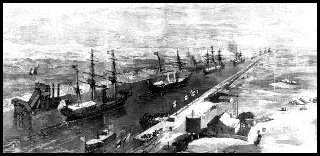Suez Canal

|
The Suez Canal, located at the crossroads of Asia, Europe, and Africa, is one of the world's most important waterways. Opened in 1869, the sea-level artificial waterway crosses the narrow Isthmus of Suez joining Africa and Asia and permits oceangoing vessels to travel between the eastern end of the Mediterranean Sea and the Indian Ocean via the Gulf of Suez and Red Sea. The canal is owned and operated by Egypt and separates the main part of that country on the west bank from the Sinai Peninsula on the east bank.
Widened and deepened over the years, it now handles ships with a maximum draft of 16.2 m
(53 ft). No locks interrupt traffic, and transit time averages about 15 hours. The present water route between the two oceans was preceded as early as the 19th century BC by an east-west canal from the Nile River to the Red Sea. It was filled in for military reasons in AD 775 by Caliph Abu Jaafer Abdullah al-Mansur. In 1798, Napoleon Bonaparte ordered a survey made in 1799 for a direct canal from the Mediterranean Sea to the Red Sea, but the project was abandoned when the French survey team mistakenly concluded that a sea-level canal was impossible. In 1854 and 1856, Ferdinand de Lesseps obtained rights from Said Pasha, khedive of Egypt, to establish a company to build and operate for 99 years a canal open to the ships of all nations. Construction was completed in 1869 at more than double the originally estimated cost of $41,860,000. The United Kingdom acquired a controlling interest in the company when the debt-ridden khedive, Ismail Pasha, was forced to sell his holdings in 1875. In 1888 freedom of passage for all ships of all nations in peace and in war was guaranteed by the Convention of Constantinople, the United Kingdom guaranteeing those and its own rights to the canal after Egypt became independent in 1936. Israel, created in 1948, was, however, denied passage after the first of the Arab-Israeli Wars, although cargoes destined for Israel on non-Israeli ships were permitted in 1952-53, 1957-59, and after 1975. Egypt's President Gamal Abdel Nasser precipitated the Suez Crisis on July 26, 1956, by nationalizing the canal company 12 years before the 99-year lease was to end and by blocking Israel's access to the Strait of Tiran and the Gulf of Aqaba. In October 1956, Israel occupied the Sinai Peninsula, and the United Kingdom and France occupied positions along the canal. The troops of these three nations were replaced by a United Nations Emergency Force in November 1956. The canal was reopened to non-Israeli traffic in April 1957 and turned over to Egypt, which eventually compensated the former shareholders in 1958. During the Six Day War (1967) between Egypt and Israel, ships were sunk by Egypt to block the waterway, and it remained closed for 8 years. Israeli shipping rights were restored by the signing of the Egyptian-Israeli peace treaty on Mar. 26, 1979. In 1989, 17,628 vessels passed through the canal. The first of several tunnels under the canal was opened to traffic in 1980. |